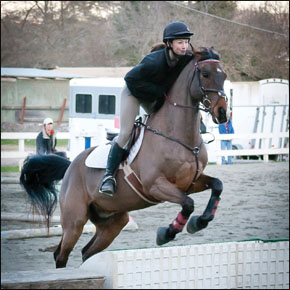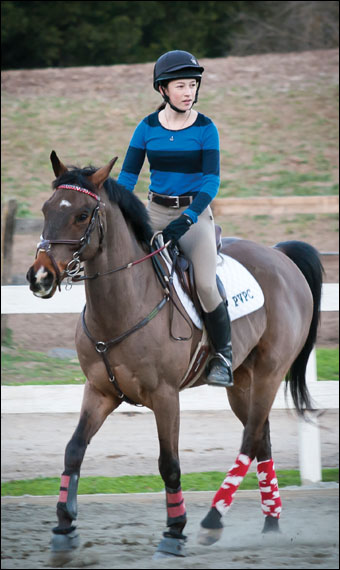

Horseback riding is one of the unique sports that many schools cannot offer due to animal involvement. Lessons are only available in barns and are therefore only offered in places of specific environments. Since San Mateo is scarcely surrounded by nature, all nearest ranches and barns preside in cities like Woodside, Half Moon Bay, and Petaluma, leaving San Mateo inactive in the horseback riding community.
Due to the dedication and commitment required to maintain horseback riding as a regular activity, many sway towards more common sports like soccer and volleyball. Yet, for senior Gaby Franco, who rode until age 12, the rareness made it more appealing. “I liked it because it was different, I didn’t know many people who did it,” she says.
Junior Skylar Assaf was introduced to the sport at age 11 through a friend who needed volunteers for a riding camp. “It was perfect because I’ve always had this dream of horseback riding,” she remarks.
Junior Marie Mihara only rides over breaks when she visits her aunt’s ranch in southern California. She’s had “horse fever” ever since her aunt, whose specially bred horse made it to the Olympic line, first introduced it to her at age two. “There’s something amazing and kind of magical about horses. They capture the imagination,” she says.
Horseback riding, like all sports, requires basic skills. “You need good position so that you have balance and don’t fall off,” says Assaf. “You need impulsion, which is a steady momentum especially when jumping. You also need the muscles to keep your horse going and your horse needs the stamina to keep itself going”.
Junior Camille Halley leases a horse in Portola Valley, where she rides at least three times a week. “There’s emphasis on how you use your aids, which is what you use to get your horse to do what you want. It’s how you communicate with your horse,” she says.
Sophomore Annika Ulrich rode passionately for 5 years, yet she stopped at the age of 7. “It’s really just about performing well with the horse,” she says.
Whether it’s a lifelong dream or a fortuitous discovery, horseback riding grows to impact all aspects of a rider’s life. “Growing up, it wasn’t Barbies for me, it was little horses,” Assaf remarks. “Now I horseback ride every day. It teaches you so much. You learn about responsibility and it makes you fit which gets you through the day easier. [Also] it’s a team effort with you and your horse so it teaches you how to work with others.”
Although Ulrich was young when she rode, she adopted lessons from its experiences. “It taught me a lot about discipline and respect because you’re working with a living being,” she says.
As transportation can often be a burden and distance is troublesome, the hassle eliminates horseback riding as an option for most. Junior Skylar Assaf, who devotes her after school time solely to riding, admits it can all get a bit much. “You have to be willing to go out once or twice a day and if [the horse is] injured or sick he obviously can’t take medication so you have to do that for him. That means going out 3 or 4 times a day or just spending the whole day at the barn. It’s a lot of commitment and that doesn’t even begin to cover the riding that it takes to keep your horse in shape and that’s a daily process that’s extremely tiring for you and your horse.”
Mihara has little time to ride during her daily life. “It’s hard because of the commute,” she says. “And it would be exhausting to balance [horseback riding] and schoolwork. I don’t have the time or the ability to do it here.”
Although most find time to ride their horses at least once a week, the steep financial costs often inhibit competitions to be a regular component in a rider’s life. Assaf does two competitions a year, but she doesn’t view the activity as a vital part of her love for the sport. “When you get wrapped up in the competition, all horseback riding is [becomes] the medals. So I try to keep it as genuine as possible – focusing and trying to train my horse and riding him instead of trying to make it about competition,” she says.
Although not competing professionally herself, Franco shares the experiences of fellow riders. “My friends who did it had to go for months making sure they knew all the tricks they needed to know, and they had to go every other day for a couple hours,” she says.
Because it involves another living being, horseback riding can often stretch beyond being a hobby and grow into a lifestyle. Mihara says that when she’s older, she’ll definitely introduce it to her children, “It’s in the family. On my mom’s side, they’ve raised horses for generations,” she says. “I’d love to continue in the future, I hope I can. Even if it’s not riding but being involved in [horses] somehow.”
Franco stopped riding regularly in the seventh grade but wants to pursue it in the future. “I’ll probably end up having my kids do it too, and I’d love to do it again,” she says.
“It really is a lot of commitment,” says Assaf. “But you can grow old with horses and that’s the greatest thing. It really keeps me going.”




